
Terraforming | Update 34
Dec 14th

If Update 34 does not download automatically, follow these update instructions. If you don’t own Universe Sandbox, you can buy it via our website.
Simulate, construct, and terraform planets and atmospheres more realistically than ever before with new materials! Planet sizes, atmospheric heating, gas and liquid colors, and more are now simulated based on the mass and phase of each material in a planet’s composition.
Learn more about how we simulate materials in two new guides
Home > Guides > Tutorials > Playing with Materials
Home > Guides > Science > Terraforming Mars

New Materials
Terraform planets, rain down oceans, and expand atmospheres with 8 new materials (for a total of 12) using the Material or Planetscaping tools, or adjust the materials directly under
Properties > Composition
In addition to silicate, iron, hydrogen, and water, we are now simulating helium, carbon dioxide, oxygen, sulfur dioxide, methane, nitrogen, argon, and ammonia.

Planet Atmospheres
Create pleasant Earth-like or oppressive Venus-like atmospheres by adjusting the mix of materials in the atmosphere. Atmosphere colors are based on the amount of gas in a specific area, with thicker atmospheres being harder to see through.


Material Collisions
Bombard planets with materials to see their atmospheres and oceans indefinitely altered. Watch oceans boil, creating vapor-filled atmospheres. Impacts create shockwaves that push gases and punch holes in the atmosphere.
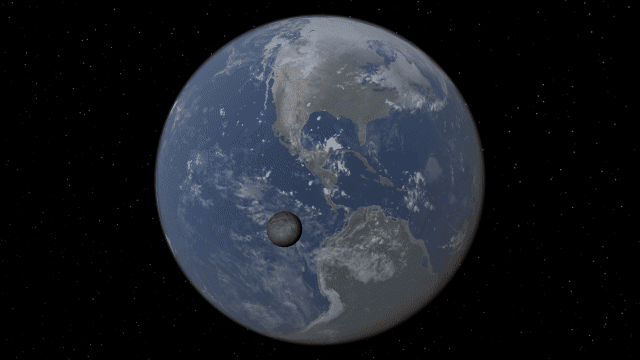

Object Size from Composition
We’re using complex models of materials under the intense heat and pressure inside planets to compute realistic planet sizes.
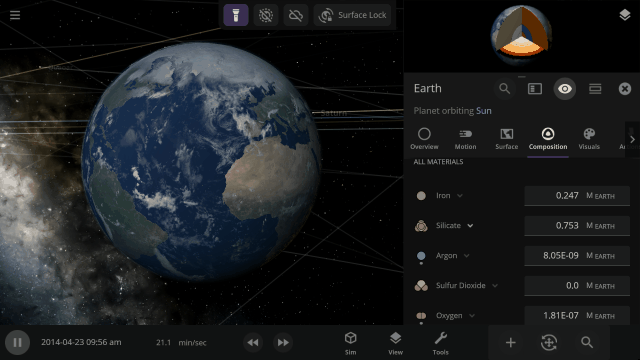
More Highlights
Material colors are based on their real-life properties. Materials blend on the surface of planets and moons so you can watch oceans and gas clouds mix in real time. You can also customize material colors under
View > Advanced View Settings > Materials


Adding materials beyond water allows us to simulate Titan’s methane lakes. In the future, these new materials will also be the foundation for simulating life.
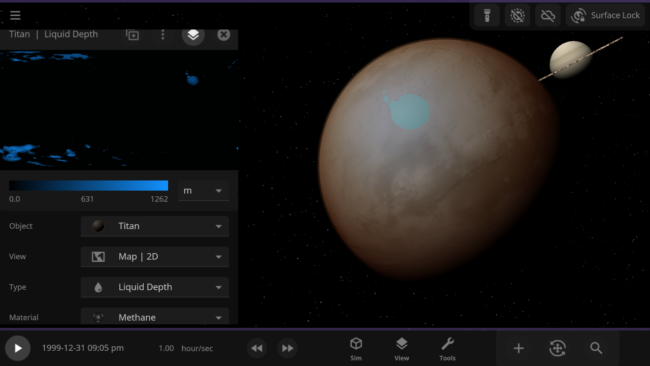
The 4 materials with the most mass will automatically be simulated across an object’s surface, indicated by a dot, similar to how water was simulated. You can also override this and choose any 4 materials to simulate across an object’s surface.

We’ve added a collection of material simulations so you can compare how they change phase between solid, liquid, and gas
Home > Open > Materials

The simulation below shows Earth with different materials in each column and a different amount of that material as a liquid in each row. Some evaporate immediately, and some stay liquid under Earth-like conditions.
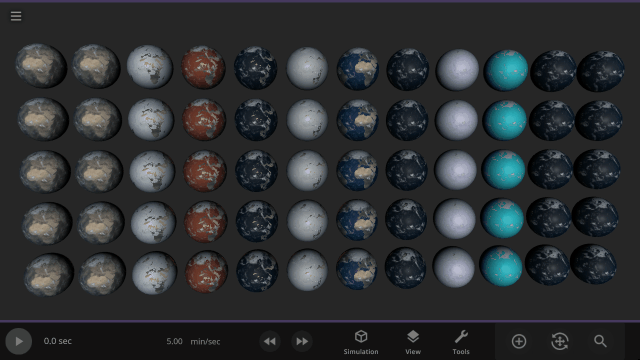
Easily change the atmospheres of custom planets, old and new, using atmosphere presets of known terrestrial planets. This interface is a work in progress.

Materials masses can be viewed and adjusted by phase (solid, liquid, gas) or collectively at once under an object’s Composition.

More accessible View toggles make it easy to turn on surface lock, illuminate the dark side of planets, or toggle the visibility of atmospheres and clouds.

City Lights and Vegetation now require a habitable gas pressure of 0.6 to 1.6 bars and a new habitable temperature of -25 °C to 55 °C (previously -55 °C to 55 °C) and to appear when set to “If Habitable.”
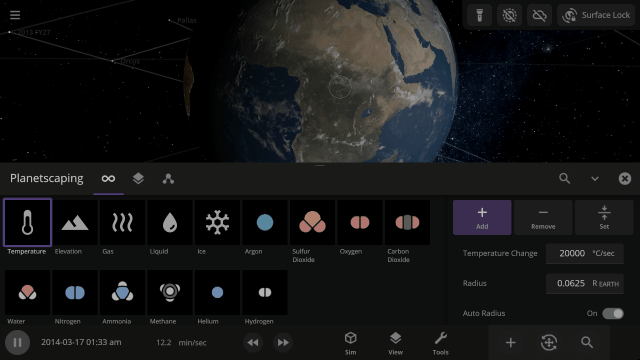
Use object Markers (formerly called Icons) to clearly see the position and movement of objects and particles in a simulation, like nebula in a galaxy, under
View > Markers

Check out the full list of What’s New in Update 34
Please report any issues on our Steam forum, on Discord, or in-game via Home > Send Feedback.
Known Limitations & Planned Improvements
- Only water vapor and gaseous carbon dioxide contribute to our simple atmospheric heating model. We plan to add heating from methane and other greenhouse gases in the future.
- Silicate and iron can only exist on the inside of a planet, not on the surface or in the atmosphere.
- To minimize the impact to performance, only a maximum of 4 materials can be simulated flowing across an object’s surface at a time. We plan to increase the number of materials simulated on object surfaces in the future.
- When a new material replaces one of the 4 simulated materials, it is evenly distributed over the surface, which can cause an atmosphere to seemingly “pop” into existence.
- Materials not simulated across the surface of objects do affect their atmospheric heating, but do not affect the atmosphere opacity.
- Planning updates to the materials interface, including:
- Viewing materials as a percentage of the mass
- Updated Phase Diagram interface
- Updated Atmosphere Preset selection interface
- Better explanation of the Composition cutaway view
- Add the ability to easily replace one material with another
- The maximum speed liquids and gases can flow across object surfaces is slower than the maximum speed of material phase changes and simulation speed.
- Computing planet radii from their composition does not take into account the object’s surface temperature (so heating a gas giant won’t make it expand, for example).
- Phase changes (like evaporation) do not affect the surface temperature of an object.
- Materials in small asteroids do not undergo phase changes.
- Materials transferred during collisions are currently always transferred in the liquid phase (although they can change phase quickly after being transferred).
- The color of Titan’s atmosphere is not fully simulated because they are caused by tiny amounts of organic particles called tholins that are not simulated in Universe Sandbox. We plan to simulate the colors of hazes like those in Titan’s atmosphere in the future.

Terraforming Preview | Adding More Materials to Universe Sandbox
Oct 24th

Our new composition system, including eight new materials, like oxygen and methane, is still in active development and has not been released, but you can opt-in to a preview version now on Steam. Every planet in Universe Sandbox is simulated with a combination of materials, like iron and water, that are used to compute properties like planet radius and water flow. However, our current composition system is too simple to simulate phenomena like lakes of liquid methane on Saturn’s moon Titan. Our new system will allow you to realistically simulate planet surfaces and atmospheres, accurately terraform planets, and more.
Try the Terraforming | Update 34 preview right now!
Eight new materials and our new composition system are now available for testing and feedback. Learn how to opt-in to a preview version on Steam:
https://universesandbox.com/support/previewversion
Material Properties in Universe Sandbox

Current Composition System
Universe Sandbox’s current composition system uses four materials (iron, silicate, water, and hydrogen) each with a set of physical properties including
- Density – to compute an object’s mass and radius and determine where materials are within a planet (for example, iron is the densest so it’s at the core).
- Thermal capacity – energy required to increase the material’s temperature by one degree. Used to determine the Surface Heat Capacity of a planet.
- Molecular weight – average mass of a molecule of the material. Used to create clouds of evaporating gas called volatiles.
Water, the only material currently simulated across an object’s surface, has some additional properties
- Boiling point – temperature where a material changes from a liquid to a gas
- Melting point – temperature where a material changes from a solid to a liquid
- Mass of the material in each phase (solid, liquid, or gas)
- Liquid and solid density, heat of fusion, and heat of vaporization – to determine how fast water flows, evaporates, and freezes on planet surfaces
- Realistic (and customizable) colors
New Composition System
Our new composition system has 12 materials: iron, silicate, water, hydrogen, helium, carbon dioxide, oxygen, sulfur dioxide, methane, nitrogen, argon, and ammonia. These are the materials necessary to simulate the most interesting internal, liquid, and atmospheric properties of most objects in our Solar System. Many, like oxygen and carbon dioxide, will also be necessary for life simulation.
Each material has all the properties described above, and they will update in real-time according to the conditions on the planet (though iron and silicate will only exist inside planets and won’t have customizable colors). Want to know the freezing point of carbon dioxide or see how fast it’s evaporating on your custom planet? We’ll simulate it in real time.
Using New Materials for Simulation
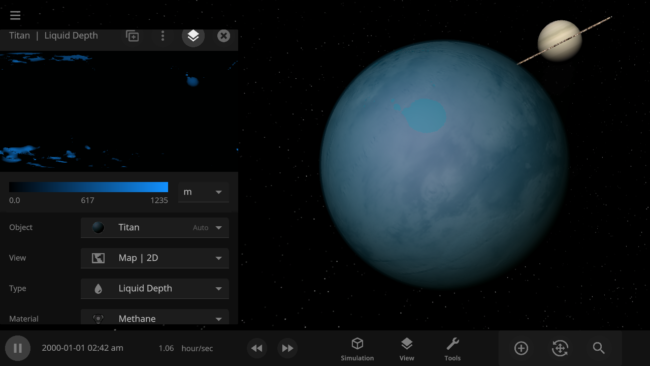
Material Phases
In our new system, all new materials can exist inside of, on the surface of, or in the atmosphere of a planet. A material’s phase will be simulated based on its temperature and pressure using something called a phase diagram. Our phase diagrams, which show a material’s state at different temperatures and pressures, are based on data taken in labs as well as geological and astrophysical models of planets. Check out the real-life phase diagram of water from Wikipedia as an example, pictured below.

We plan to show the phase diagrams we’re using to simulate each material eventually, but right now, they’re primarily for testing. Our phase diagrams have been simplified for performance reasons but still closely reflect the scientific phase diagrams. You can compare our water phase diagram below, which has been edited for clarity, to the real-life phase diagram of water above.

Planet Interiors
The cores of planets are hot and under intense pressure. These extreme conditions affect a material’s phase and density and thus the volume the material takes up in a planet’s interior. We’re using realistic models of planet density to compute and dynamically update planet radii from their compositions.


The graphs above show Earth’s density based on depth (or radius) in Universe Sandbox (top) compared to a scientifically researched model (bottom). While our in-game model is simplified, both graphs have the same shape and similar densities when compared to the radius. Comparing models allows us to check the integrity of our in-game model.
Our new composition model is more realistic but does not account for the porosity, or amount of tiny holes, of the internal structure of some objects, like the Moon. This means our model simulates some object radii slightly smaller than in real life. To account for this, we’ve added a porosity factor, which is usually an increase of a few percent, to adjust known object radii to match their real values.
The materials on the inside of planets, including iron and silicate (which are only simulated in planet interiors), do not mix together like materials on the surface or in atmospheres. Instead, we simulate planet interiors with layers of individual materials to accurately compute their radii.

Surfaces

Planets can be constructed with any (or all) of the materials available in Universe Sandbox using the Planetscaping tool, Material tool, or an object’s Composition tab. The four materials with the most mass are automatically simulated across an object’s surface, similar to how water is simulated now. You’ll also be able to override this and choose which four materials to simulate across an object’s surface regardless of mass.
Surface materials freeze into ices, evaporate to become part of the atmosphere, and melt or condensate to flow together and form oceans. This allows us to realistically simulate phenomena like the lakes of liquid methane on Saturn’s moon Titan and plumes of gas evaporating into the atmosphere during collisions.

We plan to increase the number of simulated surface materials in the future, but we’re still determining the best way to do that without decreasing performance. For now, we’ve found that four materials allow for realistic simulation and fun experimentation without significantly affecting performance.
We simulate material colors on the surface and in the atmosphere based on their thickness and scientific measurements of how much light they absorb and emit. The colors of materials in each phase are also customizable across the simulation. For example, liquid water has the same base color on all planets (not including other color changes from the atmosphere or starlight).
Our material color simulation only simulates single material colors and doesn’t include any complex particles that might normally be suspended in them in real life. This means Venus and Titan may not look completely realistic yet because their atmosphere color comes from tiny amounts of complex materials not in Universe Sandbox. We are actively working on the best way to realistically simulate these colors.
Atmospheres

Atmosphere color, opacity, amount of atmospheric heating (the greenhouse effect), and amount of Rayleigh scattering (which determines how light scatters in the atmosphere and is what makes Earth’s daytime sky appear blue) on planets is realistically simulated from the mixture of gasses in a planet’s atmosphere.
You can create realistic Earth-like atmospheres for habitable planets and oppressive Venus-like atmospheres just based on their compositions. Currently in Universe Sandbox, this is only possible by manually changing a planet’s Infrared Emissivity, which can increase the amount of heat the atmosphere of a planet retains.
The color and opacity are simulated locally throughout a planet’s atmosphere. If you add lots of oxygen in a single region of a planet’s atmosphere, it will get more opaque and change color based on the amount of oxygen in just that area.
New Minimum Operating System Requirements
To add new materials and eventually simulate more than four materials across planet surfaces, we will be dropping support for Windows 7 when this feature is released.
While it is never fun to have support dropped, this will affect just 0.25% of our users and will allow us to leverage newer computational methods to increase the performance of our surface simulation.
We’ll make sure all users who are affected by this change will be able to access the final version of Universe Sandbox with Windows 7 support.
What’s Still Being Worked On?

We’ve been prioritizing designing the properties, data views, and tools for you to easily construct atmospheres, build and terraform planets, and track these materials, but the interface for using them is still a work in progress.
Planets saved in previous versions of Universe Sandbox will only have the previous four materials, which will look and behave differently in our new composition system. Imagine Earth with a pure hydrogen atmosphere – not very realistic. We’re still trying to make this process as smooth as possible, and eventually, you’ll be able to easily update your planet’s atmosphere to be similar to Earth, Venus, Mars, or Titan.
And like any new feature, there may be bugs we have yet to find and fix – and you can help!
Try the Terraforming | Update 34 preview right now!
Eight new materials and our new composition system are now available for testing and feedback. Learn how to opt-in to a preview version on Steam:
https://universesandbox.com/support/previewversion
Let us know what you think and show us what you do with these new materials!
Join our community discussions on our Steam Forum and our official Discord community.

Universe Sandbox for Mobile | Development Challenges | Update 2
Aug 23rd
Bringing the complete Universe Sandbox experience to mobile is an exciting and challenging project, and while development was stalled while hiring a new user interface engineer, we are back on track! While we still don’t have a release date for Universe Sandbox on mobile, we want to share our recent progress and current obstacles.
For an overview of our plans for Universe Sandbox on mobile devices, you can read our first Mobile DevLog.

Pocket-Sized Complexities
We’ve been thinking about Universe Sandbox mobile for a long time and have been developing our panels and buttons to be easy to view and use on small screens for years. In fact, Universe Sandbox mobile is built from the exact same code as the version you already know and love, so it will have the same features and user interface as the desktop experience.
This shared codebase means you can enjoy any new features and improvements we add to Universe Sandbox on any device, whether you’re on a desktop, laptop, VR headset, phone, or tablet.
While these are seemingly simple goals, they create complex design challenges:
- How to automatically arrange panels and adjust your view so you can focus on controlling the simulation, not having to manage the user interface
- Switching between multiple panels, like an object’s properties, data views, and guide instructions, on small screens in landscape and portrait modes
- Overhauling our simulation tools (like explode, laser, and planetscaping), to adapt to all screen sizes
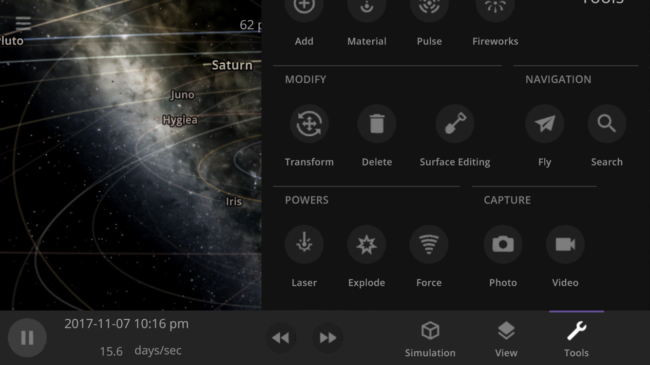
Under New (Layout) Management
While most other simulators and games have a different user interface for their mobile and desktop versions, we want ours to use the exact same interface for all platforms. We think we’re among the first to do this, but if you know of another or have done this with your game, please let us know! You can see what Universe Sandbox mobile might look like right now (including why we haven’t released it yet) by resizing the Universe Sandbox window on your computer to the size of your phone (since our user interface dynamically responds to your window size).
While we are still making performance improvements so Universe Sandbox can run smoothly on phones, our primary obstacle in mobile development is ensuring our interface is usable on a small touch screen like a phone. We’ve started tackling it by designing a system to intelligently hide and reveal panels as they open and close, which we’re calling our Dynamic Layout System.
While creating this system will take time, it should allow future improvements and new features to work in Universe Sandbox without any extra development, regardless of whether you’re playing on mobile or desktop. That means we’ll have more time to work on new features instead of spending time implementing the same feature in two different ways.

Current Progress
We’ve been researching the best way to create this dynamic panel management system and have made significant progress implementing it within Universe Sandbox.
There’s still other work to be done, and we do not have a release date or official price for mobile, but we’re still planning on it being a one-time paid app with no ads or in-app purchases.
We have yet to finalize the minimum device requirements for the mobile version, but it will likely require a modern device with decent specs. We will share more about hardware requirements as soon as we finalize them.
Taking a feature-rich, user-interface-heavy desktop game and porting it to mobile presents many challenges, but we are excited to tackle them and create an experience unlike any other at your fingertips.
To receive updates about mobile, like this one, sign up for our mailing list:
http://universesandbox.com/mobile/
Join our community discussions on our Steam Forum and our official Discord community.

Gravity Simulation Upgrade | Update 33
Aug 16th

If Update 33 does not download automatically, follow these update instructions. If you don’t own Universe Sandbox, you can buy it via our website.
Gravity Simulation
We’ve completely overhauled our gravity simulation to increase accuracy, stability, and overall performance. Run simulations at higher speeds than ever before while maintaining gravitational accuracy.

Many simulations can now be run at noticeably higher simulation speeds. Try increasing the simulation speed of the Solar System simulation or your own custom simulation.

Before

After
The Hubble Space Telescope used to crash into or fly away from Earth at simulation speeds greater than a couple days per second. Now it maintains a stable orbit at much higher simulation speeds.


Choreography simulations, where moons are distributed evenly over a pre-computed path creating a unique design, are much more stable and create the desired patterns, like this fish, before becoming gravitationally unstable and falling apart, as expected.


We’ve also added more controls so you can fine-tune the balance between maximum simulation speed and gravitational accuracy. Learn more in our updated guide
Guides > Tutorials > Advanced Simulation Speed Controls
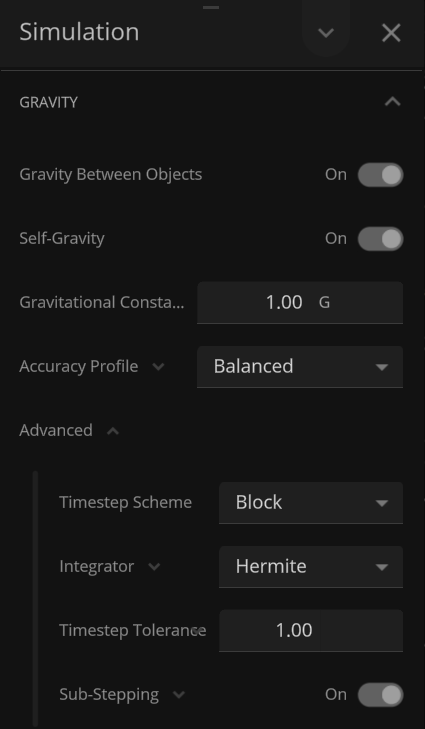
More Highlights
Small objects colliding with gas giants now create more realistic impacts with smaller, gradually growing impact areas


Object selection has been completely rewritten. It’s now much easier to select objects in crowded simulations with lots of dust clouds and fragments.


Check out the full list of What’s New in Update 33
Please report any issues on our Steam forum, on Discord, or in-game via Home > Send Feedback.
The Future of Universe Sandbox on Linux
Jul 12th
Our latest release, Update 32.3, will be our last with a native Linux version of Universe Sandbox. Future Linux versions of Universe Sandbox on Steam will be powered by Valve’s Proton, software built into Steam that allows Windows games to run on Linux.
If you are a Steam Linux player, no action is required to continue playing Universe Sandbox. This change should be seamless.
We know this may be disappointing, but after internal testing and user feedback, we have found that playing Universe Sandbox through Proton on Linux machines provides a better overall experience. Valve has put a tremendous amount of energy into developing Proton, which has made this decision much easier. As a small indie team, the upkeep of a Linux version was disproportionately high compared to the size of the Linux player base (just over 0.5% of all players).
Due to the limitations of the Steam platform, we can no longer provide access to older native Linux versions. If you are a Steam player who needs access to the last Linux native version (Update 32.3), please contact us.
If you are a GOG or Itch player, older releases will remain available in their respective download sections. We recommend GOG and Itch players on Linux use either Heroic Games Launcher or Lutris for future versions.

Grand Collision Unification | Update 32.3
Jun 29th

If Update 32.3 does not download automatically, follow these update instructions. If you don’t own Universe Sandbox, you can buy it via our website.
We’ve combined our two previously separate collision methods improving collisions so shockwaves now realistically eject fragments as they spread across gas giants during collisions. Interface panels, such as graphs, data maps, and object properties, are now remembered when you open saved simulations. We’ve also added new astronomical discoveries to explore, like the galaxy-sized detector used to find new evidence of supermassive black holes.

Unified Collisions
Collisions are more realistic, with shockwaves propagating across gas giant surfaces and fragment ejection direction based on impact angle with our new unified collision system. This new collision solution combines our two previous separate collision methods.




Saving Your Interface
Pick up right where you left off with the properties panel open, or include a temperature graph in a shared simulation to show a planet heating up from a close encounter with a star. Saved simulations now remember the state of the interface panels. See it in action in
Open > Core > A Tidally Heated Habitable Moon or Tidally Locked Earth
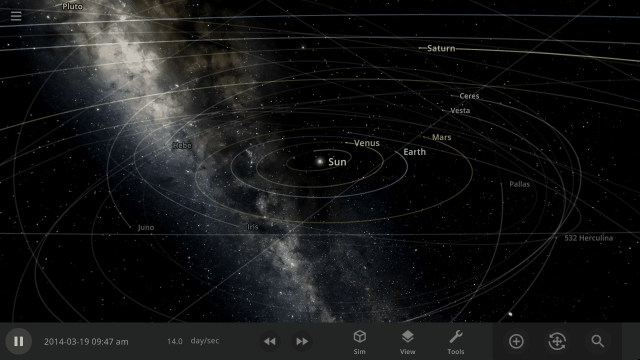

Searching for Supermassive Black Holes
On June 28, 2023, evidence for a signal generated from all supermassive black hole pairs from across the universe was announced by the North American Nanohertz Observatory for Gravitational Waves. Explore the galaxy-sized detector they used and learn how they found this evidence in our new guide
Guides > Discoveries > Searching for Supermassive Black Holes

More Highlights
See the dwarf planet Quaoar’s newly discovered rings in the new simulation
Open > Solar System > Quaoar with Rings

We’ve also added a simulation of the dwarf planet Haumea’s rings, which were discovered back in 2017, in the simulation
Open > Solar System > Haumea with Rings

Manipulate the temperature of the universe and learn about the cosmic microwave background, a type of faint radiation spread across space, in our new guide
Guides > Science > Cosmic Microwave Background

Display settings have been updated to include more options for exclusive fullscreen, fullscreen borderless, and windowed resolutions


Additional Actions have been added to the Properties panel of objects so you can easily Fly To, Follow, or Land on objects

Default temperature unit can now be changed to °F, only °C, or only K under
Settings > General > Temperature Units

Check out the full list of What’s New in Update 32.3
Please report any issues on our Steam forum, on Discord, or in-game via Home > Send Feedback.

Universe Sandbox Roadmap: 2023 & Beyond
Mar 31st

We’re working to give you more power to understand and control the complex phenomena of the universe. Our roadmap for 2023 includes simulating the lakes of liquid methane on Titan, hot planets emitting light, and realistically colliding spacecraft and bananas. But before we dive in, let’s recap some accomplishments from last year.
Highlights From 2022

In 2022, we put out 9 updates for Universe Sandbox. These included many new features, but some of our favorites are
- Spinning up planets so fast they break apart using the new Force Spin tool
- Exploring constellations for 10 different cultures
- Customizing the look and topography of planets and moons with a library of realistic color and height maps
- Fundamental improvements to our planetary collision system
Check out our 2022 Retrospective for more on what we did last year.
So What’s the Plan for 2023?
- Add more materials for constructing & simulating planets & atmospheres
- Overhaul our under-the-hood physics architecture to improve accuracy and performance
- Simulate light emission from hot planets
- Continue work on bringing Universe Sandbox to phones and tablets
- Improve our development tools to identify issues quickly and provide a more bug-free experience
Many of our projects, like bringing Universe Sandbox to phones and tablets, have been in development for months or years. While we plan to work on everything we discuss here in 2023, complications may cause features to be delayed, and our priorities may change.
More Materials & Composition Simulation

We’re expanding the number of materials in Universe Sandbox you can use to simulate, construct, and terraform planets and atmospheres realistically. For example, new materials like methane will allow us to fully simulate lakes of liquid methane on Titan. We’re also adding advanced simulation to compute planet radii based on the pressure and temperature of each material in the planet’s composition. Ever wonder how big the Moon would be if it were made entirely of oxygen? Soon you’ll be able to find out.
- A (Multi) Material World
- Planet radii and atmospheres will be realistically simulated based on the mass and phase (solid, liquid, and gas) of each material in their composition.
- Simulation of an atmosphere’s heating (the greenhouse effect), color, and opacity, including Venus-like atmospheres, will be based on their material composition.
- Designing the properties, data views, and tools for you to construct atmospheres, build and terraform planets, and track these materials is a crucial part of our development process.

- Physics-based Phases
- The phase of each material in a planet’s composition will be realistically determined based on its pressure and temperature. Make a planet entirely out of water and see the phases from the inside out (our current model says it would be 100% liquid inside).
- Material phase models are based on geological and astrophysical measurements and research.
- Planet radii will then be calculated based on the phase and density of each material that makes up a planet’s composition. If you change the composition, the radius will change with it.
- The phase of each material in a planet’s composition will be realistically determined based on its pressure and temperature. Make a planet entirely out of water and see the phases from the inside out (our current model says it would be 100% liquid inside).
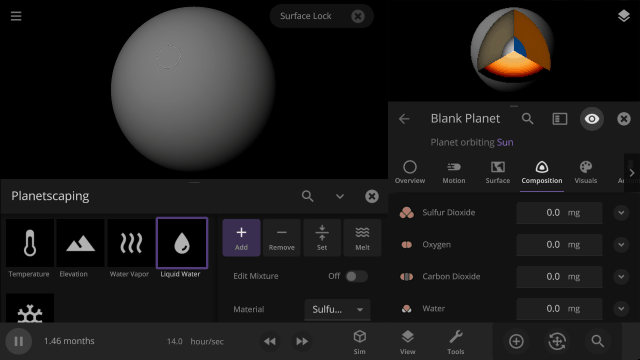
- Tracking Materials
- Materials will have customizable colors based on their physical properties that will blend on the surface of objects. Watch oceans of methane mix with oceans of oxygen in real time.
Physics Fundamentals

Our project to add everyday object collisions, like throwing a banana at a car, led us to first rewrite our physics architecture. Realistically smashing satellites together is part of continuous efforts to improve the realism and performance of Universe Sandbox.
- New Physics Architecture
- Overhauling our custom N-body (gravity) simulation will improve gravity-related accuracy, stability, and performance. Tight orbits like the Hubble Space Telescope around Earth should be stable at simulation speeds as high as a month per second (instead of a few days).
- These updates are the foundation for future physics improvements, like spaceships.


- Everyday Object Collisions
- Currently, when objects collide, they’re treated as spheres. We’re working on adding new physics so that everyday objects, simple shapes like dice and pyramids, but also complex shapes like sledgehammers and spacecraft, will collide according to their unique forms. This is often known as rigid body collision physics.
- Improved Planetary Collisions
- We’re researching methods to allow objects to stretch and deform, like two fluids mixing, during collisions, to improve upon the sphere absorbing method we currently use. Stay tuned for a status update later this year.
- Meteors & Shooting Stars
- To simulate meteors and shooting stars, we’re working on allowing objects to burn up while traveling through a planet’s atmosphere. We’re exploring ways of applying this drag force to objects passing through gas clouds and liquids too. Currently, atmospheres have no effect on objects as they pass through them.

- Advanced Game Engine Features
- As an ongoing project to optimize our simulation, we’re transitioning to the Data-Oriented Technology Stack (DOTS) from Unity, the game engine we use to build Universe Sandbox. We’re excited about the expected performance gains.
Lights in Space

We want to light up the universe – by allowing hot planets and moons to emit light. We’re also planning a massive graphics overhaul that will change how you see the Universe (Sandbox).
- Light ‘em Up
- Light – it’s not just for stars anymore. Hot planets will emit light based on their temperature so you can light up your simulation by setting Earth to 1000 °C.
- This lighting system will eventually allow you to place and customize lights anywhere in the simulation so you can illuminate your universe without stars.
- Untitled Graphics Overhaul
- We don’t want to say too much yet, but we’re working on a massive update to our graphics system that the whole team is very excited about.
Universe Sandbox on Tablets & Phones

We’re stepping up our development for Universe Sandbox on mobile devices (for iOS and Android) after some delays last year. You can read about our plans in our first Mobile DevLog, and be on the lookout for more updates in the future.
- Small Screen Experience
- The primary obstacle in mobile development is adapting our interface that works well on a large screen to work on a small touch screen (like a phone).
- We’re building a system to intelligently resize, hide, and reveal panels as needed. Our goal is to reduce the need for you to spend time managing the user interface so you can focus on bending the simulation to your will.
- All of the Above
- Universe Sandbox on mobile is built from the same codebase as the desktop version and will have the same features.
- Performance is also critical, and we’re working to make Universe Sandbox run smoothly on mobile devices no matter the simulation.
Enhancing Our Developer Toolkit
We’re creating new internal tools to make developing and releasing updates of Universe Sandbox faster. These include systems to analyze your feedback and automate testing for bugs and issues.
- Testing 1, 2, 3
- Creating tests that run automatically to check our collision physics, simulation performance, and more will help us catch issues before they’re released. These tests record data and images we can use to find bugs more easily.
- Tracking Feedback
- Your in-game feedback and issue reports help us improve Universe Sandbox, and there’s a lot to review. We’re transitioning to a new system to sort and analyze your feedback more efficiently.
- Building the Sandbox
- We’ve revamped our automated build system. This system creates a new version of Universe Sandbox in the cloud every time a change is made by one of our team members.
- This automation saves each of us 10-15 minutes each time we want to review a change.
- With a single button, we can also release new updates to all digital stores that sell Universe Sandbox. This process used to take many hours and involved dozens of manual steps, so this makes it possible to release more updates faster.
- This new system easily makes versions of Universe Sandbox we can test on phones and tablets (iOS and Android) too.
- We’ve revamped our automated build system. This system creates a new version of Universe Sandbox in the cloud every time a change is made by one of our team members.
- New Trailer
- We’re producing a new Universe Sandbox trailer fabricated entirely in-game. We’ll be able to capture it with a single button press, making it easier to iterate on the trailer over time to show off the latest features and improvements.
- You will be able to play this new trailer inside Universe Sandbox, breaking out of it to experiment or explore every shot and simulation.
And Beyond

We’re always thinking about the future of Universe Sandbox. Our longer-term goals include gamepad support, life simulation, and more planet customization options. These are still in early development, and we don’t have a timeline for their release (because software development is hard, and not even our astrophysicists can predict all of the complexities of simulating the universe).
- Custom Textures
- We want to give you more control over the appearance of your planet. Satisfy your world-building desires by creating a planet using custom maps or images, like a picture of your dog.
- Gamepad Support
- What could be better than playing Universe Sandbox from the comfort of your couch? We’re working on adding gamepad support for more ways to control your universe. This will improve our Steam Deck support and has the potential to support other gamepad-based systems in the future.
- Life Simulation
- Our expanded materials improvement is the cornerstone of our plans for life simulation. Once Universe Sandbox includes the essentials for life, like oxygen and carbon dioxide, we will be able to explore simulating simple life that will spread across the surface of a planet.
We’re excited for the year ahead and can’t wait to make Universe Sandbox even better!

A Comet, an Asteroid, and a Planet Walk into the Solar System | Update 32.2
Mar 23rd

If Update 32.2 does not download automatically, follow these update instructions. If you don’t own Universe Sandbox, you can buy it via our website.
Watch a green comet pass by Earth for the first time in 50,000 years, see an asteroid swing by Earth in one of the closest ever encounters, and explore a hypothetical planet from the 1800s disproven by Einstein’s theory of relativity. Speaking of comets, asteroids, and planets…
A comet, an asteroid, and a hypothetical planet walk into the Solar System. The hypothetical planet says to the comet, “Why so green?” The comet says, “It’s the radiation from the Sun evaporating the carbon on my surface. You’d know that if you were as close to the Sun as people thought you were.” The hypothetical planet turns red with anger and ceases to exist. The asteroid says, “Phew, that was a close one!”

A Green Comet
The green comet, C/2022 E3 (ZTF), recently passed by the Earth for the first time in 50,000 years. Explore its path and watch this once-in-a-lifetime event occur over and over with our new simulation
The Green Comet C/2022 E3 (ZTF) in 2023

Close Encounters of the Asteroid Kind
Asteroid 2023 BU performed a close pass of Earth (though it posed no threat), only 2,200 km from the surface. That’s just under half the length of the United States! Watch one of the closest asteroid encounters ever recorded in our new simulation
Asteroid 2023 BU Close Encounter in 2023
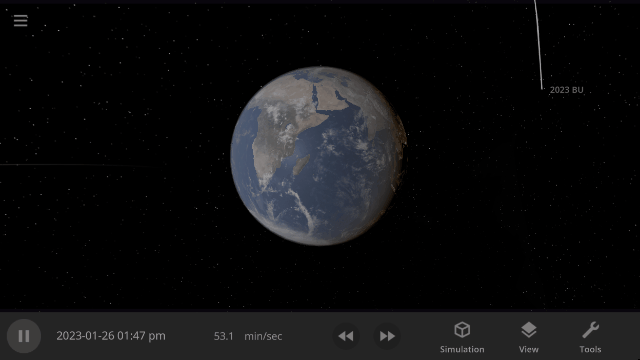
The Non-Existent Planet
In the 1800s, many astronomers thought there was a planet, dubbed Vulcan, between Mercury and the Sun. Mercury’s orbit was observed to wobble slightly more than predicted, and Vulcan was hypothesized to explain this. We now know Vulcan does not exist, and general relativity causes the additional wobble, but you can see Vulcan’s proposed orbit in the new simulation
Hypothetical Planet Vulcan

More Highlights
Landing (press “c”) on the surface of a planet now always points you toward the horizon. Taking off returns you to your previous position instead of in front of the planet.

On February 3, 2023, astronomers announced the discovery of 12 more moons orbiting Jupiter. Learn about these new moons in our new simulation
Jupiter’s New Moons 2023
Or explore the history of the discovery of all of Jupiter’s 92 moons in our guide
History of Jupiter’s Moons

We added a Spherical Cow to Universe Sandbox! This refers to a joke that when physicists want to make a problem easier to handle, they sometimes simplify it so much it’s no longer realistic.

Experience 100 spherical cows hitting Earth at lightspeed in our new sim
Earth & 100 Spherical Cows at the Speed of Light
Because why not?

Check out the full list of What’s New in Update 32.2
Please report any issues on our Steam forum, on Discord, or in-game via Home > Send Feedback.

Universe Sandbox 2022 Retrospective
Mar 2nd

We’re excited about our plans for 2023, including adding more materials to planets as well as improvements for our physics simulation, but we’ll dive into our roadmap in an upcoming post. First, let’s reflect on some of our accomplishments from 2022.
1
New team member
Last year, Conrad joined the team as our User Interface Engineer. Since then, Conrad has been adding interface controls for object customization, fixing general usability issues, and helping to make our user interface easy to use on small screens in preparation for Universe Sandbox on mobile.
8
New guides and fly-by simulations added to Universe Sandbox in 2022
We added new guides on object customization and a simulation of NASA’s DART mission. This ambitious mission tested humanity’s ability to deflect asteroids away from Earth by intentionally crashing a satellite into an asteroid and accurately predicting the change in the asteroid’s orbital period.
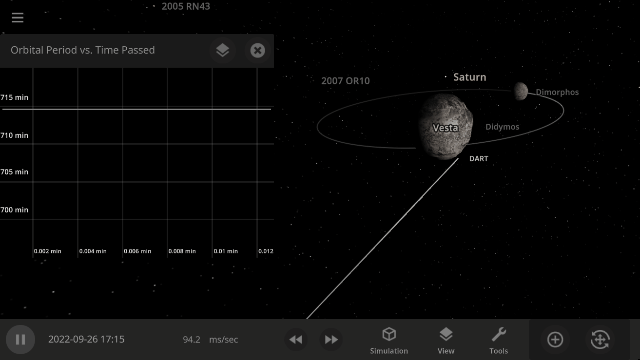
9
Significant updates to Universe Sandbox
- Consistent Collisions, James Webb, & Planetscaping Tweaks | Update 29.1
- JWST is now in Universe Sandbox, and there’s an eyedropper for the Planetscaping tool
- Hit Hard, Spin Fast | Update 30
- The new Force Spin tool allows you to spin apart planets with the newly implemented centrifugal force
- Collisions between spinning and equal-size objects are more realistic than ever before
- The habitable zone is now simulated using the selected planet’s properties, and the Hubble Space Telescope is now in Universe Sandbox
- Constellations | Update 31
- Explore constellations for 10 different cultures
- Object glows now correspond to how hot an object is
- A Warmer Welcome | Update 31.1
- Our welcome guides have been overhauled so you can discover the infinite power to create and destroy in Universe Sandbox
- Upgrading Our Engine | Update 31.2
- We updated Unity, the game engine we use to create Universe Sandbox, to allow us to utilize new features for future improvements
- Instantly see where water will flow on a planet with the new Settle Water button
- Planetary Defense DART | Update 31.3
- Many collision improvements and a simulation of NASA’s DART mission, which intentionally collided the DART spacecraft with the asteroid Dimorphos, changing its orbit & testing humanity’s ability to protect Earth from future asteroids
- Space is Big | Update 31.4
- Units of measurement have been updated to help you better understand the vastness of space
- Build-A-Planet | Update 32
- Customize and manipulate the appearance and elevation of planets using any of the in-game visual and elevation maps
- Skies of Blue, Red Collisions Too | Update 32.1
- Collision shockwaves are now more realistic, and we added basic Rayleigh scattering to atmospheres
- The simulation speed can automatically adjust itself based on various conditions, like nearby objects and collisions, by turning on Automatic Simulation Speed
View our “What’s New” for a chronological list of changes.
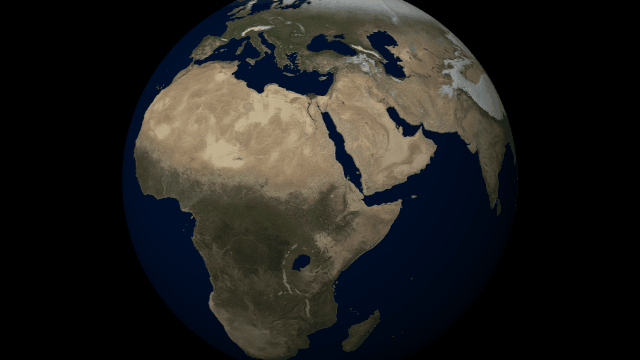
31
Preview versions uploaded in 2022
Your playtesting of our preview versions (previously called community test builds) gives us valuable feedback for improving features in active development. A huge thanks to our wonderful community for all their help.
571
Highest number of concurrent users in Universe Sandbox in 2022
The highest number of concurrent users we’ve ever had was almost in 2022: 648 on December 24, 2021. We’ve already beaten the highest number this year, but you’ll need to wait for the next retrospective to see it.
1,801
Positive Steam reviews in 2022
We’re truly humbled that we are still rated “Overwhelmingly Positive,” both recent and all-time on Steam (over 96% of reviews are positive). Your support and feedback are truly appreciated and help make Universe Sandbox even better.

1,862
Code commits, or changes, made to the Universe Sandbox project in 2022
The most code commits occurred during the week of May 8, when 65 commits were made. While a single commit can be as small as fixing a typo, some of them have been whole new features.

7,735
Files uploaded on our team messaging app
These are files we share with each other via Slack and include screenshots and videos of features in progress, log files for resolving issues, and astronomy jokes.

8,151
Discord users on our server at the end of 2022
It’s great to see your creations and constructive discussion on our server, which has grown by over 22.5% in the last year. Join us on Discord.
9,253
Simulations shared in the Universe Sandbox Steam Workshop in 2022
That’s more than 25 simulations shared every single day! You all continue to use Universe Sandbox in ways we could never have imagined, and we can’t wait to see what you make next.
74,257
Messages sent on our team messaging app
Giant Army has been entirely remote since its founding in 2011, and with 13 team members across 3 continents and 6 time zones, messaging on Slack is how we get most of our work done.
537,209
Times the Welcome to Universe Sandbox guide was played
Whether you’re a new player or just wanted to check out the reimagined welcome guides we released last year, we hope you enjoyed learning about the beauty of our universe. You’re using that knowledge responsibly, right?

911,241
Times the Planetscaping tool was used in 2022
Letting you shape and customize planets is integral to the spirit of Universe Sandbox, and we’re glad you’re experimenting with the power that comes with it.

1,251,635
Times supernovas went off in Universe Sandbox in 2022
Astronomers estimate there will be 1 supernova in the Milky Way every 100 years. They also think there are about 100 billion galaxies in the universe. Assuming all galaxies have a similar number of supernovas to ours, there are about a billion supernovas in the universe each year. We got about 0.1%* of the way there in 2022. Let’s see if we can get closer in 2023!
*Thanks to Steam user Nantes for pointing out that the original value of 1% was wrong, and this should be 0.1%

2,007,301
Times the top played simulations of 2022 were opened*
The top 10 sims of 2022 were:
| Rank | Simulation Name | Times Opened |
| 10 | Saturn with Rings | 129,522 |
| 9 | Voyager 1 & Jupiter in 1979 | 130,275 |
| 8 | Solar System – Just Planets | 136,798 |
| 7 | Milky Way & Andromeda Galaxy Collision | 145,261 |
| 6 | Earth & 100 Colliding Moons | 171,990 |
| 5 | Earth & Moon | 173,774 |
| 4 | Tidally Locked Earth | 177,224 |
| 3 | Milky Way | 189,958 |
| 2 | Galaxy Collision Hi-res | 227,148 |
| 1 | Solar System – Live View – Planets, Moons, Spacecraft | 525,351 |
*not including creating a new simulation or the Solar System simulation that opens when you start Universe Sandbox
Check them out to see what all the fuss is about!

3,987,005
Times the Force tool was used in 2022
Whether you were giving planets a gentle nudge, slightly adjusting their rotation, or spinning them apart, we know you were forceful in your efforts.

6,265,426
New simulations were created in Universe Sandbox in 2022
That’s about the same number as last year, with a new simulation created every 5 seconds.
35,802,793
Times a simulation was played or paused in 2022
By far the most popular thing to do in Universe Sandbox in 2022 was to play or pause a simulation. That’s about once every second.
What’s Next?
More materials for building planets and their atmospheres, physics simulation performance improvements, non-star objects emitting light based on their temperature, and more are in store for 2023. Be on the lookout for our 2023 Roadmap, which will have more details about our plans for this year.

And Most Importantly…
Thank you. Your continued encouragement and support let us keep simulating the universe more realistically year after year. We are so grateful for your suggestions, feedback, and kind words. The simulations you create continue to impress us, and we want to continue improving Universe Sandbox to expand your creative (and destructive) capabilities. There’s so much to do, and we can’t wait to do it!
The Universe Sandbox Team
Dan, Chris, Georg, Jonathan, Rappo, Mat, Jacob, Erika, Brendan, Anders, Brent, Pavel, and Conrad

Skies of Blue, Red Collisions Too | Update 32.1
Dec 14th

If Update 32.1 does not download automatically, follow these update instructions. If you don’t own Universe Sandbox, you can buy it via our website.
Collision shockwaves and atmosphere colors are more realistic, camera motion is smoother, and you can try the new Automatic Simulation Speed, which adjusts the simulation speed based on what’s happening in the simulation. Never miss a collision again!

Improved Shockwaves
Energy from collisions spreads more realistically over the surface of an object, resulting in larger shockwaves. Heating from collisions is also less concentrated and spreads over a larger area. Previously, shockwave expansion ended abruptly in a smaller area, often resulting in blue-hot impact sites.
The dwarf planet Ceres colliding with Earth
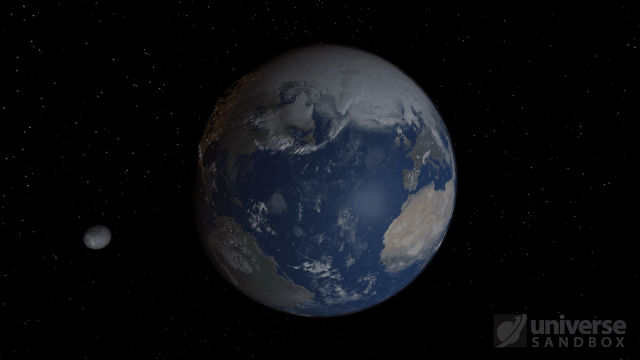

The Moon colliding with the Earth
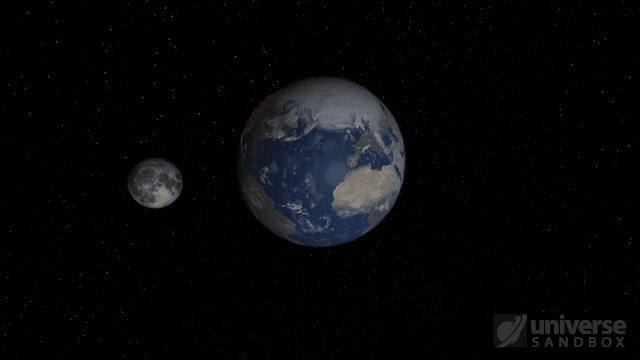

Automatic Simulation Speed
Allow the simulation speed to adjust itself automatically based on various conditions, like nearby objects and collisions, by turning on the new Automatic Simulation Speed feature. Automatically speeding up and slowing down the simulation speed provides an improved viewing experience for collisions, orbits, explosions, and more.
This feature is still in active development and is currently off by default. Turn it on under
Settings > General > Experience > Auto Simulation Speed

The simulation speed will slow down to show collisions that you might otherwise miss


Create a more cinematic experience while watching simulations like Earth & 100 colliding moons


Rayleigh Scattering
Object atmospheres now visually simulate Rayleigh scattering, which describes how light scatters in the atmosphere. Rayleigh scattering is what makes Earth’s daytime sky appear blue and the setting Sun appear red. Adjust the strength of the scattering under
Visuals > Atmosphere > Rayleigh Scattering Strength
Earth with realistic Rayleigh scattering


Custom object with Rayleigh scattering at 85% strength


More Highlights
Your view now smoothly rotates, or pans, to focus on an object instead of sliding the view left or right, like a camera on rails


Atmospheres are now visible from the surface of planets. Land on a planet by pressing “c” on your keyboard to check it out.


Check out the full list of What’s New in Update 32.1
Please report any issues on our Steam forum, on Discord, or in-game via Home > Send Feedback.
